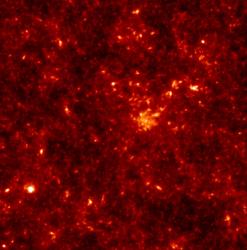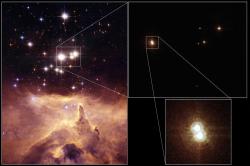 Dark matter is invisible to all our instruments, but that doesn’t mean it isn’t there. It does reach out to regular matter with its gravity. A new technique being developed at the Max Planck Institute for Astrophysics might be able to make dark matter reveal itself. A large enough radio telescope should be able to map the radiation from pregalactic hydrogen – formed shortly after the big bang, and visible in all directions. Any intervening dark matter will distort this radiation, like ripples in a pond, revealing its presence and quantity.
Dark matter is invisible to all our instruments, but that doesn’t mean it isn’t there. It does reach out to regular matter with its gravity. A new technique being developed at the Max Planck Institute for Astrophysics might be able to make dark matter reveal itself. A large enough radio telescope should be able to map the radiation from pregalactic hydrogen – formed shortly after the big bang, and visible in all directions. Any intervening dark matter will distort this radiation, like ripples in a pond, revealing its presence and quantity.
Continue reading “New Technique Could Reveal Dark Matter”
Heavy Stars Embedded in NGC 6357
 This Hubble photograph shows star cluster Pismis 24, which lies at the heart of emission nebula NGC 6357. The stars are some of the most massive ever seen in our galaxy, each of which weighs at least 100 times the mass of our Sun. Astronomers originally thought it was two stars, each of which exceeded the theoretical limits on stellar size. Hubble discovered that it’s actually three stars, bringing the reality back in line with theory.
This Hubble photograph shows star cluster Pismis 24, which lies at the heart of emission nebula NGC 6357. The stars are some of the most massive ever seen in our galaxy, each of which weighs at least 100 times the mass of our Sun. Astronomers originally thought it was two stars, each of which exceeded the theoretical limits on stellar size. Hubble discovered that it’s actually three stars, bringing the reality back in line with theory.
Continue reading “Heavy Stars Embedded in NGC 6357”
What Makes the Biggest Impact on Galactic Evolution?
Astronomers assume that the galaxies we see today are the result of billions of years of evolution. Collision after collision turned small, irregular galaxies into majestic spirals like our Milky Way. But does the evolution depend on starting conditions, or is it all about the galactic collisions? A recent survey of more than 6,500 galaxies at various distances shows the environment of the early Universe made a significant impact on the evolution of the galaxies we see today. So both the early environment and ongoing collisions played a part.
Continue reading “What Makes the Biggest Impact on Galactic Evolution?”
Supermassive Black Hole Mashes Up and Consumes a Star
A supermassive black hole in a distant galaxy has been caught in the act of consuming a star. In fact, NASA’s Galaxy Evolution Explorer was able to watch the entire process, from the beginning to the end. A some point in the recent past, a star got too close to the supermassive black hole, and was torn apart. The shreds swirled around the black hole, and the Galaxy Evolution Explorer spotted the bright blast of ultraviolet light.
Continue reading “Supermassive Black Hole Mashes Up and Consumes a Star”
First Negatively Charged Space Molecules Discovered
Until now, all the molecules discovered in space were either neutral or positive in charge. But astronomers have turned up a rare negative molecule called C6H-. Molecules like this are thought to be extremely rare in space, because the ultraviolet light radiated from stars easily knocks electrons off molecules, changing their polarity. The molecule was discovered in the vicinity of two nebulae by the Robert C. Byrd Green Bank Telescope.
Continue reading “First Negatively Charged Space Molecules Discovered”
The Great Observatories View Supernova Remnant N49
Hubble, Chandra, and Spitzer – NASA’s three Great Observatories – teamed up to create this beautiful photograph of supernova remnant N49. Under visible light, this is the brightest remnant in the Large Magellanic Cloud. It has a strange lopsided shape; unusual because most supernova remnants are spherical. The new data from the triplet of telescopes have revealed that the strange shape is happening because the remnant is expanding into a region of denser gas on one side.
Continue reading “The Great Observatories View Supernova Remnant N49”
Measuring the Shape of Supernove Explosions
Type 1a supernovae are used to measure distance in the Universe because they explode with the same brightness, detonating when a white dwarf star consumes a specific amount of material from a binary companion. The accuracy of these distance measurements depends on the shape of the blast. New research indicates that Type 1a supernovae explosions start out clumpy and uneven, but a second, spherical blast overwhelms the first creating a smooth residue. This sets the limits of uncertainty on distance measurements that use Type 1a supernovae.
Continue reading “Measuring the Shape of Supernove Explosions”
Searching for Dark Matter Particles Here on Earth
Astronomers don’t know what dark matter is, but they do know it takes up approximately 25% of the Universe. We can’t see it, but we can measure the effect of its gravity on stars and galaxies. A powerful detector, deep underground in a mineshaft in Minnesota might be able to get to the bottom of the mystery. The Cryogenic Dark Matter Search II project will attempt to detect Weakly Interacting Massive Particles (aka WIMPS). These theoretical particles don’t normally interact with matter, but the occasional rare collision might be detectable.
Continue reading “Searching for Dark Matter Particles Here on Earth”
Set Your Clock with Gamma Rays
Astronomers have discovered a gamma ray source in the sky that acts like a natural clock. The object is called LS 5039, and consists of a massive blue star orbiting an unknown object – possibly a black hole. The two objects orbit each other closely, completing an orbit every four days. With each orbit, the black hole flies through the blue star’s stellar wind, and accelerates particles to gamma ray levels. This is the first time a source of gamma rays has been discovered with such a regular schedule.
Continue reading “Set Your Clock with Gamma Rays”
Starburst Galaxy NGC 1313
This is an image of galaxy NGC 1313, taken with the FORS instrument at the ESO’s Very Large Telescope. It’s classified as a starburst galaxy, because of the dense regions of furious star formation. NGC 1313 is relatively close to the Milky Way, located only 15 million light-years away. To say it’s forming many new stars is an understatement; NGC 1313 has a rate of star formation 1000x faster than the Milky Way. Galaxies like this usually went through a recent collision with another galaxy, but astronomers can’t find the culprit anywhere near.
Continue reading “Starburst Galaxy NGC 1313”
